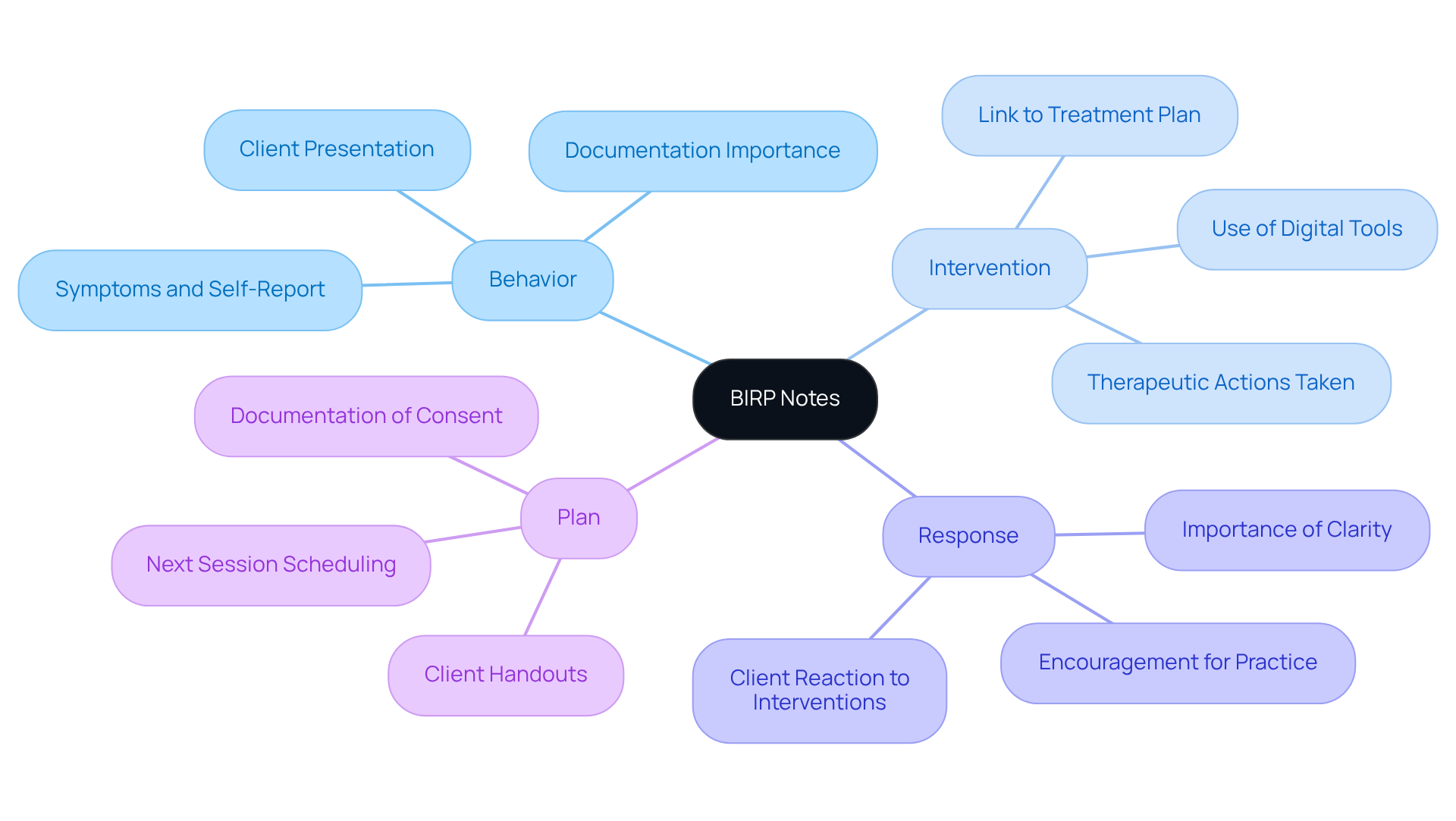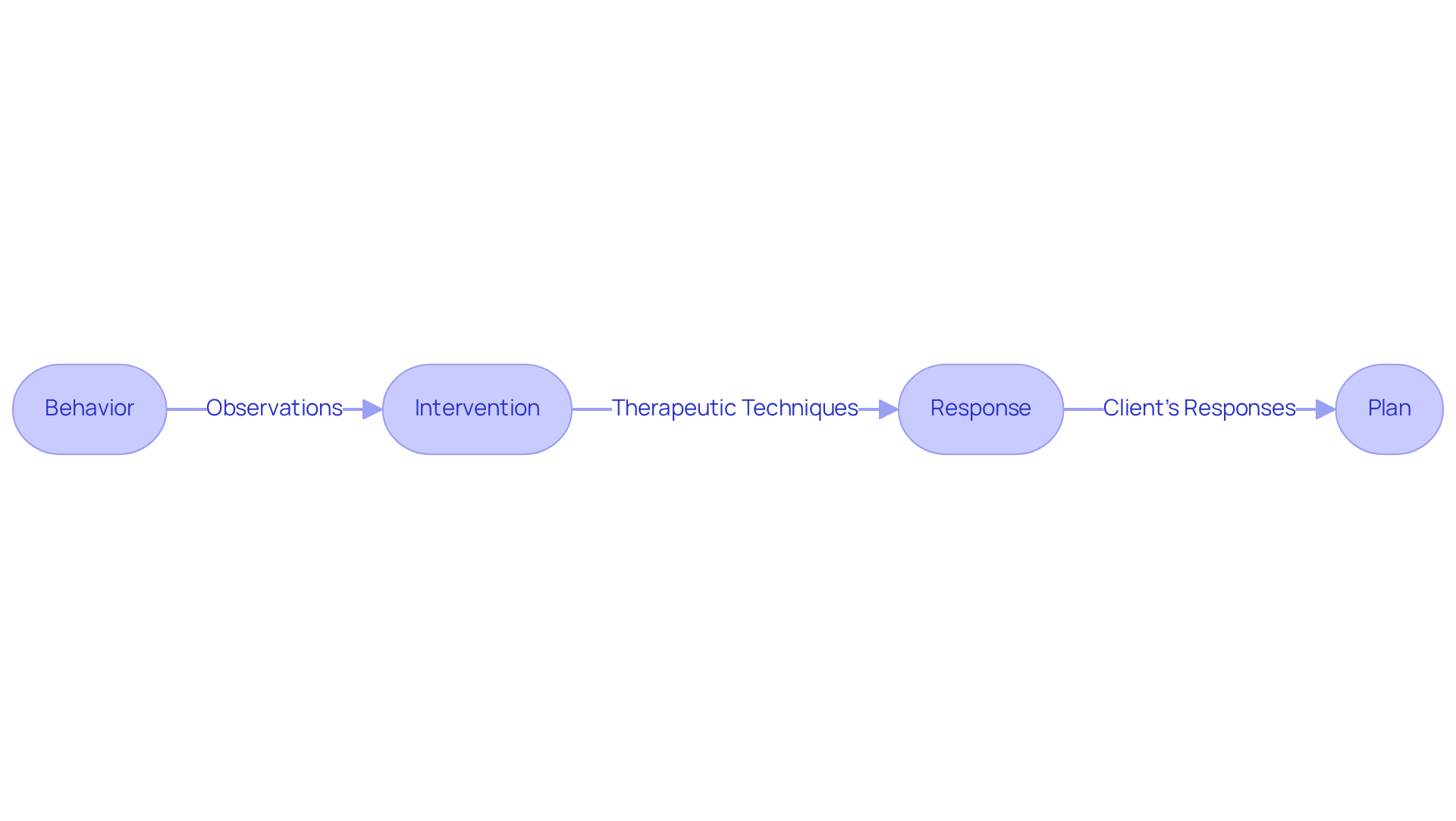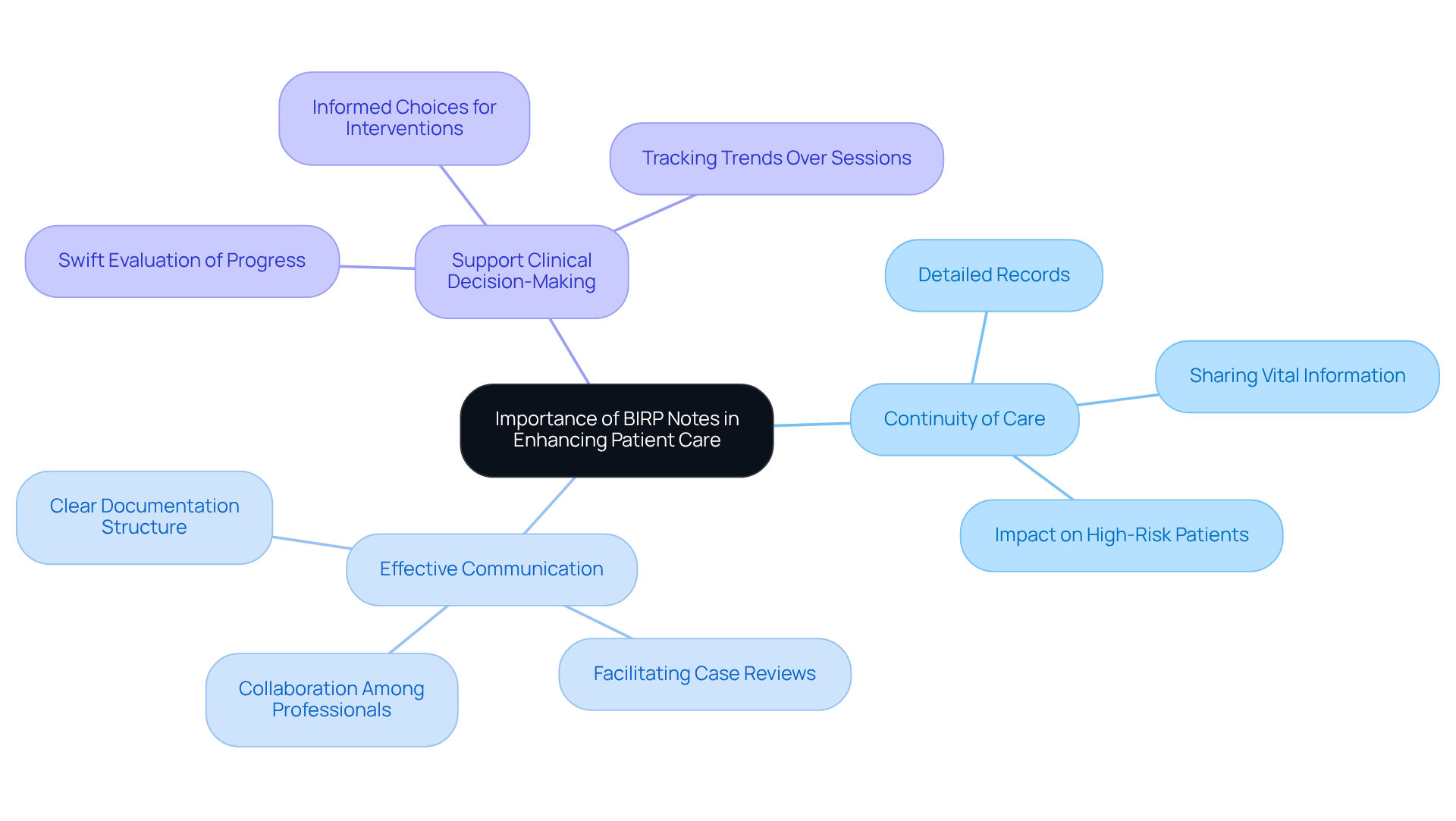Overview
BIRP notes—Behavior, Intervention, Response, and Plan—offer a compassionate framework for mental health documentation. They not only enhance communication between clinicians and clients but also support the vital tracking of treatment progress. Have you ever felt overwhelmed by the administrative demands of your role? This method alleviates some of those burdens by organizing essential information into clear categories.
By implementing BIRP notes, you can foster continuity of care and improve collaboration among healthcare providers. Imagine the impact this could have on your clinical decision-making, ultimately leading to better patient outcomes. Reflecting on your experiences, how might this structured approach transform your practice?
As you consider these benefits, remember that adopting BIRP notes can be a step towards more effective and empathetic patient care. Embrace this opportunity to enhance your documentation process and support your patients more meaningfully.
Introduction
Understanding the nuances of mental health documentation is essential for clinicians who genuinely care about providing effective support. The BIRP method—comprising Behavior, Intervention, Response, and Plan—offers a structured approach to recording vital interactions and treatment strategies. This framework not only streamlines documentation but also enhances communication among healthcare providers, ultimately leading to better patient outcomes.
Yet, many practitioners may wonder: how can they fully leverage this method to capture the complexities of their clients' experiences? Reflecting on this can help clinicians navigate the emotional challenges they face in their practice. By addressing the administrative burdens that often weigh them down, they can focus more on what truly matters—their patients' well-being.
Define BIRP Notes: Understanding Their Role in Mental Health Documentation
Mental health experts often face emotional challenges in their work, and the structured format they use can significantly ease these burdens. The B-I-R-P method—Behavior, Intervention, Response, and Plan—answers the question of what does BIRP notes stand for by providing a clear framework for recording interactions and treatment plans efficiently. This approach not only helps clinicians monitor client progress but also fosters effective communication among healthcare providers, enhancing the overall care experience.
Imagine being able to maintain continuity of care while ensuring that every detail is captured promptly. Ideally, progress reports should be composed within 24 hours of each session, guaranteeing that precise information is preserved. By organizing information into these four categories, BIRP records allow clinicians to keep a concise account of each session, typically ranging from 100 to 300 words. This clarity is crucial for both clinical evaluations and billing needs.
Moreover, it's essential to avoid common writing errors, such as overgeneralizing or including unrelated information, to improve the quality of these records. The Response section is particularly vital, as it captures the client's immediate relief from interventions and encourages practice between sessions. Have you considered how much smoother your documentation process could be by adhering to these guidelines?
Additionally, compliance with HIPAA is paramount for behavioral health records. This ensures secure storage and access by authorized individuals, strengthening the legal defensibility of your documentation. By adopting the B-I-R-P format, it is important to understand what does BIRP notes stand for to enhance your practice while providing compassionate care to your clients.

Break Down the Components of BIRP Notes: Behavior, Intervention, Response, and Plan
The BIRP note format serves as a vital tool for clinicians, encompassing four key components that foster understanding and connection during therapy sessions:
-
Behavior (B): In this section, we capture the observable behaviors, thoughts, and emotions of the individual during the session. It includes both self-reported feelings and clinician observations, offering a comprehensive view of the individual's current state. How might these insights shape our approach to care?
-
Intervention (I): Here, clinicians document the therapeutic techniques and strategies employed during the session. This may involve particular interventions, such as cognitive-behavioral techniques or mindfulness exercises, tailored to meet the individual's unique needs. Reflecting on these strategies, how do they resonate with your experiences in practice?
-
Response (R): This section outlines the individual’s responses to the interventions implemented. It includes any changes in behavior, mood, or insight, allowing clinicians to assess the effectiveness of their strategies. What patterns do you notice in these responses, and how can they inform future sessions?
-
Plan (P): The final component outlines the next steps in the treatment process. This may involve setting goals for future sessions, recommending additional resources, or adjusting the treatment plan based on the individual's progress. Together, these components create a holistic view of the individual's journey through therapy, guiding us in providing compassionate care.
By utilizing the BIRP format, we not only enhance our documentation practices but also deepen our understanding of what does BIRP notes stand for in the therapeutic process, which ultimately benefits the individuals we serve.

Explore Practical Applications of BIRP Notes: Examples and Use Cases in Therapy
In various therapeutic settings, including individual therapy, group therapy, and family counseling, it is essential to understand what BIRP notes stand for, as they serve as a vital resource. They address four crucial questions about the therapy session: what was observed (Behavior), what was done (Intervention), how the individual responded (Response), and what does BIRP notes stand for in terms of the next steps (Plan). How can we ensure that every voice is heard in this process?
In individual therapy, a clinician might document a client's anxiety symptoms as the behavior, utilize relaxation techniques as the intervention, and note the client's reported decrease in anxiety as the response. The plan may include continuing to practice these techniques in future sessions, scheduling the next appointment, and assigning homework. This structured approach not only tracks progress but also informs necessary treatment adjustments, allowing for a more personalized experience.
In group therapy, the facilitator may record the group's dynamics and individual contributions as the behavior, implement group discussions as the intervention, and observe changes in group cohesion as the response. Planning future topics based on group feedback captures the collective experience and personal insights, fostering a deeper understanding of the therapeutic process. How might this collective insight enhance our approach to care?
These examples illustrate what BIRP notes stand for, as they effectively summarize the complexities of therapy sessions and ensure all relevant information is documented for ongoing treatment and assessment. Specific formats provide a common framework for therapy records, which can be integrated with Electronic Health Records (EHR) systems to simplify the recording process. By maintaining a clear and succinct format, these records improve communication among practitioners and support the ongoing enhancement of therapeutic strategies. As Courtney Gardner, MSW, insightfully notes, 'Quoting those you work with directly in your therapy progress records can be incredibly powerful,' emphasizing the importance of capturing individuals' voices in documentation.

The Importance of BIRP Notes in Enhancing Patient Care
Understanding what does BIRP notes stand for is essential in enhancing patient care, ensuring that all relevant information is documented and easily accessible. This structured approach allows clinicians to truly connect with their patients and colleagues.
- Ensure Continuity of Care: By maintaining detailed records, healthcare providers can share vital information with colleagues, ensuring that every team member is informed about the client's progress and treatment plan. This is especially crucial for high-risk patients, where accurate documentation can significantly impact safety and care quality.
- Facilitate Effective Communication: These records offer a clear and concise structure for documenting interactions with individuals, simplifying the process for providers to convey essential information during case reviews or consultations. This structured communication fosters collaboration among healthcare professionals, enhancing the overall quality of care.
- Support Clinical Decision-Making: The organized format of these records enables practitioners to swiftly evaluate a patient's progress and make informed choices regarding upcoming interventions, ultimately leading to improved treatment outcomes. The organized format enhances session-to-session progress tracking, making it easier to monitor client improvements and identify trends.
At CosmaNeura, we recognize the emotional toll that the healthcare system can place on physicians, often detracting from their ability to provide quality care. Our commitment to empowering healthcare professionals through innovative solutions aligns with the organized recording of behavioral notes, underscoring the importance of transparent communication and continuity in patient care. By alleviating mental stress for professionals and ensuring that all pertinent information is readily accessible, BIRP notes not only serve as a documentation tool but also clarify what does BIRP notes stand for in delivering high-quality, patient-centered care. This dedication to quality evaluation is vital in transforming faith-based healthcare, ensuring that every interaction is not only meaningful but also impactful.

Conclusion
Understanding the significance of BIRP notes is crucial for mental health professionals striving to provide high-quality care. The B-I-R-P framework—comprising Behavior, Intervention, Response, and Plan—serves as an essential tool for clinicians to document therapy sessions effectively. This structured approach not only enhances communication among healthcare providers but also ensures that vital information is captured, facilitating continuity of care for clients.
Have you considered how each component of BIRP notes can impact your practice? The Behavior section captures observable actions and emotions, while the Intervention details the therapeutic techniques employed. The Response reflects the client's reactions, and the Plan outlines future steps in treatment. Together, these elements create a comprehensive and organized record that supports clinical decision-making and enhances patient care.
Incorporating BIRP notes into mental health documentation is more than just a procedural necessity; it is a commitment to compassionate, informed care. By utilizing this structured format, clinicians can improve their documentation practices, ultimately leading to better treatment outcomes for clients. Embracing the BIRP method not only streamlines the documentation process but also reinforces the importance of clear communication and collaboration in the therapeutic journey.
As you reflect on your own documentation practices, consider how adopting BIRP notes can transform your approach to patient care. Together, let’s foster an environment of understanding and support that prioritizes the well-being of every client.




